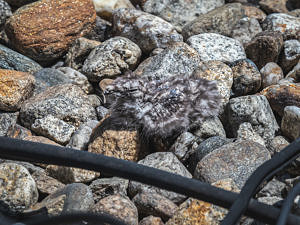Hope is the Thing With Feathers….
This is the spot for information on the search for nesting nighthawks in Keene. Think of it as a quest: a highly coveted quarry with little chance of success, but there’s joy in the journey.
Field Reports on This Page
End-of-Season Summary
Keene
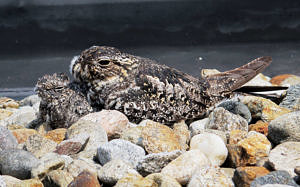
The KSC chick and mother, as they were last seen on July 6, 2021. By July 8, they were gone from their rooftop nest site. It’s possible the chick successfully fledged and was being fed by its parents nearby for another week or two, but we can’t know for sure.
(photo © Brett Amy Thelen)
For the second year in a row, a rooftop nest at Keene State College produced one chick — but, unlike last year, this year’s chick was not seen after it fledged, despite a number of nights of watching on the part of our volunteers. The adult birds stayed active near the nest site for nearly two weeks after the chick fledged, so there’s a good chance it survived and was being tended out of view — but we simply can’t know for sure. Near as we can tell, those three birds were the only breeding-season nighthawks in Keene in 2021. Huge thanks to all of this year’s volunteers, and to the Facilities staff from KSC that provided access to the roof to check on the nest!
Concord
Nighthawk watchers coordinated by NH Audubon identified 6 active sites in the greater Concord area, though some had access issues that made it difficult to confirm nesting.
Ossipee Pine Barrens
The Ossipee Pine Barrens continue to be a stronghold of nighthawk activity, with at least 4 males displaying at a single site. There is uncertainty about how this year’s gypsy moth outbreak in the pine barrens might impact nighthawks in Ossipee. Here, the birds nest on the ground, in their natural habitat, rather than on rooftops.
Migration is now underway.

The best time to see migrating nighthawks is in late August, between 5 and 7 p.m.. You’ll have to look, not listen, as migrating nighthawks tend to forage silently.
(photo © parulidae photos)
Nighthawks are among the latest migrants to arrive each spring, and the earliest to depart each “fall,” with southbound migration peaking in late August. This year, the Monadnock Region’s first migratory flock was seen in Peterborough on August 15. You can learn more about the migration here.
If you’d like to watch with other nighthawk aficionados in Keene or Peterborough, sign up for the Harris Center’s “pop-up” events email list to be notified of a nighthawk migration outing when conditions seem prime for good viewing.
If you want to look on your own, remember that nighthawk behavior changes during migration: the best time to see migrating birds is between 5 and 7:30 p.m., and you’ll have to look, not listen − migrating nighthawks tend to forage silently. It’s not uncommon to see an ethereal flock floating down Main Street in Keene or the Contoocook River in Peterborough, so keep your eyes to the skies in late August!
An Uncertain Outcome

Common Nighthawk: International Bird of Mystery.
(photo © Kenneth Cole Schneider)
Over the last two weeks, Project Nighthawk volunteers have conducted watches at KSC on six different nights. Although the adult male was active on July 9, 10, 12, 15, and 19 — and the female was sighted briefly on July 15 — the chick has not been observed since a rooftop nest check on July 6, before it fledged.
It’s unlikely the parents would have stayed so close to the nest site if the chick had not survived past fledging, but despite our best efforts, without a sighting of the chick or of the adults tending to it, we can’t confirm that the chick survived. As with so much wildlife monitoring, we’ll just have to classify this as an “uncertain outcome” and keep our feathers crossed that all three birds are safe and sound, somewhere.
Wherefore Art Thou, Chick?

The KSC nighthawk chick and its mother on July 6, 2021. Click on the image for a larger view. (photo © Brett Amy Thelen)
On Tuesday morning, the KSC chick and its mama were still hanging tight on the Elliot roof — and a watch by Sue Moran confirmed that both adults were active at the site that night. However, there were no nighthawks on the roof during a quick check between raindrops on Thursday afternoon. As of Thursday, the chick would be 20 days old — big enough to take short flights, but not yet an accomplished flyer. The early fledgling period is a particularly vulnerable time in a nighthawk chick’s life, as they can fly just well enough to leave the safety of their rooftop nest site, but not necessarily well enough to evade predators.
Now what?
If the chick is alive and well, the parents will continue to tend to it for at least another week or so, feeding it nightly as it becomes a stronger flier and learns to forage for itself. Although the activity might not be centered as closely on the Elliot roof as it was earlier in the season, the chick can’t fly far just yet, so the parents ought to be observable in the general vicinity.
You can help.
At this point, the only way to know if the KSC chick has successfully fledged is to watch for consistent nighthawk activity in the vicinity of Elliot Hall from 8 to 9:30 p.m. on calm, clear nights over the next week. Now that the chick is no longer sitting tight on the Elliot roof, the activity might have shifted as well — but it should still be relatively close by. Try watching from the sidewalk between Rhodes and the library, and from the courtyard between the library, Elliot Hall, and the Sculpture Studio, but be prepared to move around if it turns out that the birds are slightly further afield. If possible, team up with another volunteer or two, so you can get better coverage. If you are planning to head out, please let Brett know.
A Few Important Reminders
(1) Be precise in your description of the behavior you observe, particularly with regard to timing.
(2) Record it all on a data sheet (which you can download here).
(3) Email your observations to Brett Amy Thelen as soon as possible after your watch.
(4) Reports of “null data” − when you’ve looked for nighthawks, but didn’t find any − are just as important as reports of activity, especially at the nest site.
KSC Chick Two Weeks Old & Counting…
Yesterday, we were able to confirm that the KSC nighthawk chick was still alive and well after this week’s intense heat! It’s now two weeks old. If all goes well, it will likely take its first (very short) flight over the long weekend, though it will likely stick relatively close to the nest site for at least another week or two after that.
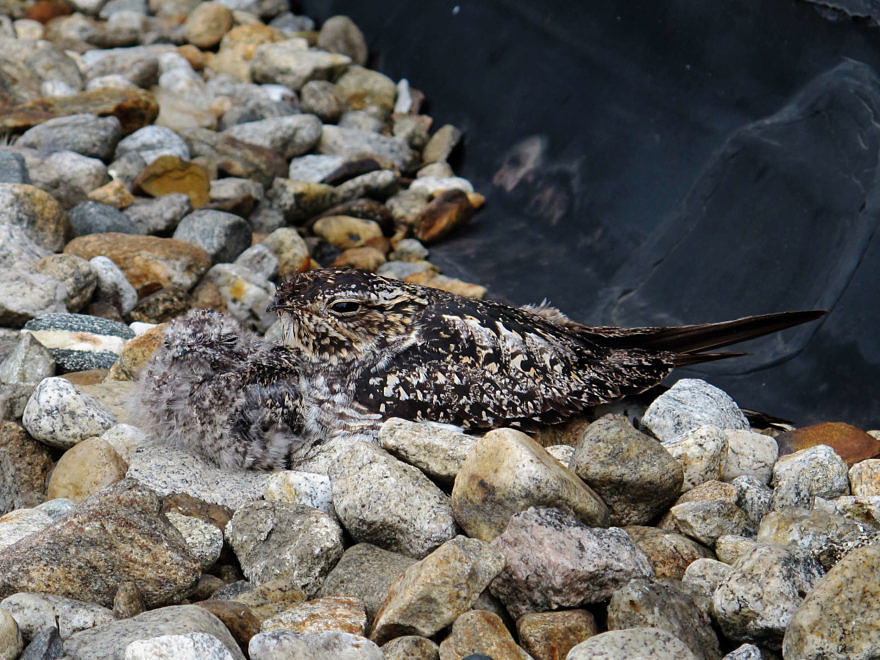
The KSC chick at two weeks old, with its mother keeping close watch. (photo © Brett Amy Thelen)
Now what?
If the chick continues to thrive, the parents will feed it nightly (even after it has taken its first flight!), resulting in a fairly predictable pattern of behavior that can be observed from the sidewalk below. If the chick does not survive, a change in the adult birds’ behavior will also clue us in to the failure.
You can help.
KSC
We are still interested in nighthawk sightings — especially booming and diving — from other parts of town, but it’s vital to continue monitoring at KSC. This nest is not easily accessible, and the best thing for the nighthawk family is to disturb them as little as possible, so watching from the ground below will be crucial for detecting nest success. Watch at Elliot Hall from 8 to 9:30 p.m. on any calm, clear night over the next few weeks. The best vantage points are from the sidewalk between Rhodes and the library, and from the courtyard between the library, Elliot Hall, and the Sculpture Studio. If possible, team up with another volunteer or two, so you can watch from different angles, and keep a sharp eye on the north side of Elliot Hall, facing the library. Nesting females can be quite stealthy.
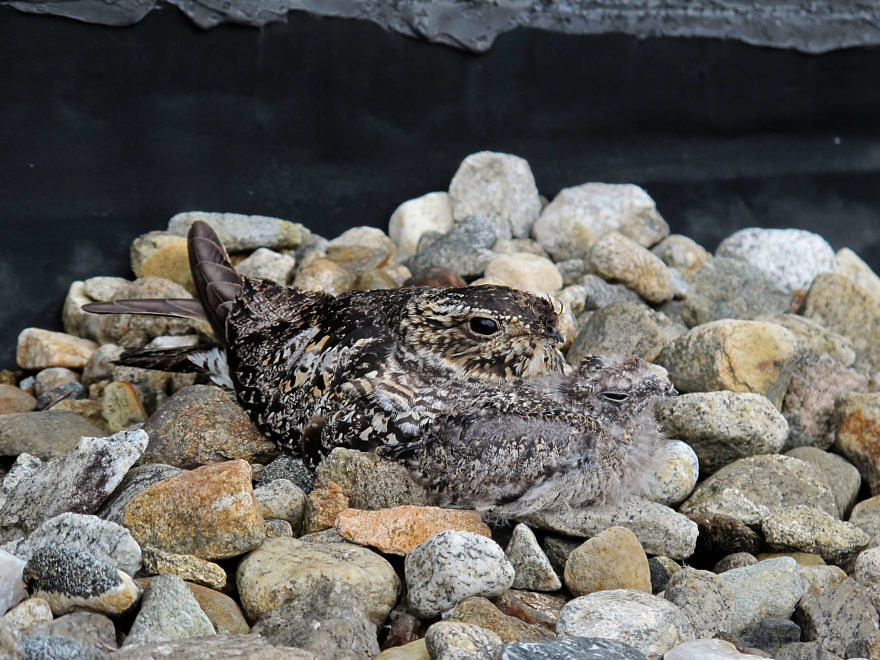
Another view of the KSC nighthawk mama and two-week-old chick on July 1, 2021. (photo © Brett Amy Thelen)
Elsewhere
Although it’s most important to monitor the KSC nighthawk family at this time, if you want to conduct individual watches at other sites with gravel roofs to determine if we have more than one breeding-season pair in Keene this year, we welcome that too. Here are a few sites that have not yet been watched: the People’s United Bank on Gilbo Avenue, the Hannafords plaza, “Washington Park” (the old Keene Middle School), the northeast corner of Central Square (in the vicinity of Luca’s and Bank of America, both of which have gravel roofs), Franklin School on Washington Street, and Production Avenue.
If you’re curious as to whether a building has a gravel roof, Google Maps satellite view is a great tool. Gravel roofs appear tan on aerial photos; vinyl roofs appear black or white. The only caveat is that Google does not reflect recent roofing work. For instance, KSC’s Media Arts Center roof was converted from gravel to vinyl three years ago, but still appears as gravel on Google.
A Few Important Reminders
(1) Be precise in your description of the behavior you observe, particularly with regard to timing.
(2) Record it all on a data sheet (which you can download here).
(3) Email your observations to Brett Amy Thelen as soon as possible after your watch.
(4) Reports of “null data” − when you’ve looked for nighthawks, but didn’t find any − are just as important as reports of activity, especially at the nest site. Peent!
One Week-Old Chick at KSC
On Wednesday, we were able to confirm that one week-old nighthawk chick was still alive and well, with an attentive nighthawk mama, on the upper roof of Elliot Hall at Keene State College! Sadly, we were also able to confirm that the second egg never hatched. There’s no guarantee that the chick will make it through this next week of heat and storms, but for now, this is hopeful news.
Now what?
If the chick survives, the parents will continue to feed it nightly, resulting in a fairly predictable pattern of behavior that can be observed from the sidewalk below. If the chick does not survive, a change in the adult birds’ behavior will also clue us in to the failure.
You can help.
KSC
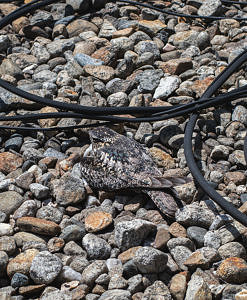
The female nighthawk, protecting her chick from the elements and potential predators. The chick is not visible as it’s fully beneath its mother, but if you look very closely in the top right of the frame, you can see the unhatched, inviable egg. Click on the image for a larger view. (photo © Dave Hoitt)
We are still interested in your nighthawk sightings — especially booming and diving — from other parts of town, but it’s vital to continue monitoring at KSC. This nest is not easily accessible, and the best thing for the nighthawk family is to disturb them as little as possible, so watching from the ground below will be crucial for detecting nest success. Watch at Elliot Hall from 8 to 9:30 p.m. on any calm, clear night over the next few weeks. The best vantage points are from the sidewalk between Rhodes and the library, and from the courtyard between the library, Elliot Hall, and the Sculpture Studio. If possible, team up with another volunteer or two, so you can watch from different angles, and keep a sharp eye on the north side of Elliot Hall, facing the library. Nesting females can be quite stealthy.
Elsewhere
Although it’s most important to monitor the KSC nighthawk family at this time, if you want to conduct individual watches at other sites with gravel roofs to determine if we have more than one breeding-season pair in Keene this year, we welcome that too.
Here are a few sites that have not yet been watched: the People’s United Bank on Gilbo Avenue, the Hannafords plaza, “Washington Park” (the old Keene Middle School), the northeast corner of Central Square (in the vicinity of Luca’s and Bank of America, both of which have gravel roofs), Franklin School on Washington Street, and Production Avenue.
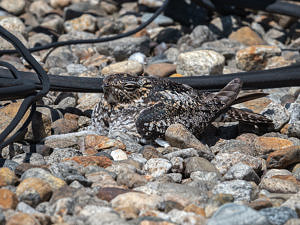
Another view of the nesting female. She looks “poofy” because she is brooding a one-week-old chick. Click on the image for a larger view. (photo © Dave Hoitt)
If you’re curious as to whether a building has a gravel roof, Google Maps satellite view is a great tool. Gravel roofs appear tan on aerial photos; vinyl roofs appear black or white. The only caveat is that Google does not reflect recent roofing work. For instance, KSC’s Media Arts Center roof was converted from gravel to vinyl three years ago, but still appears as gravel on Google.
A Few Important Reminders
(1) Be precise in your description of the behavior you observe, particularly with regard to timing.
(2) Record it all on a data sheet (which you can download here).
(3) Email your observations to Brett Amy Thelen as soon as possible after your watch.
(4) Reports of “null data” − when you’ve looked for nighthawks, but didn’t find any − are just as important as reports of activity, especially at the nest site. Peent!
A Nighthawk Nest at KSC!
Today, we were able to confirm a nest with one brand new chick, one still-unhatched egg, and one attentive nighthawk mama on the upper roof of Elliot Hall at Keene State College! The chick likely hatched within the last 24 hours. If we’re lucky, the second chick will hatch very soon. This is the most vulnerable time in a nighthawk chick’s life, so there’s no guarantee that either one will survive, but for now, this is very good news.
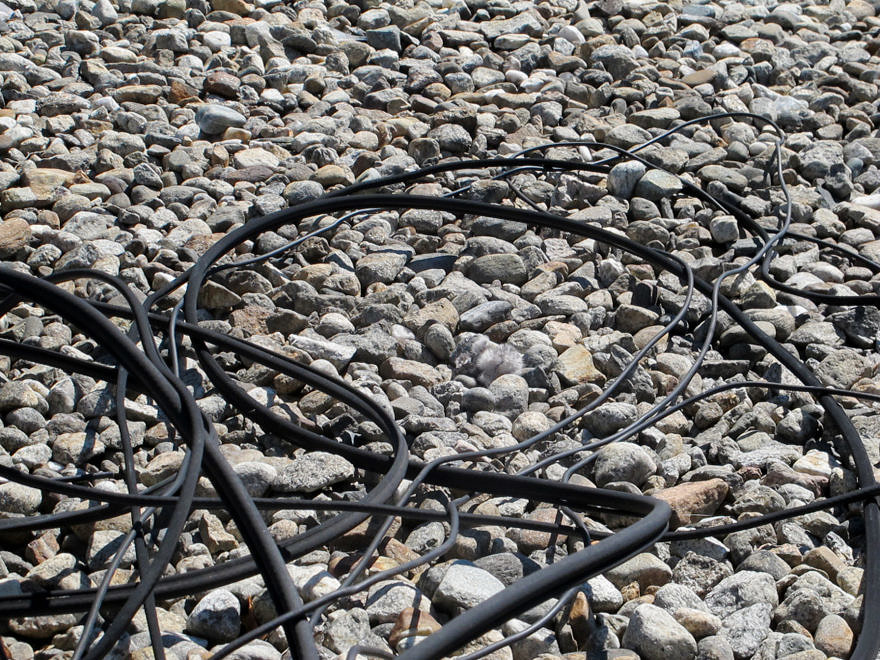
An excellent example of how well-camouflaged nighthawk eggs and chicks are! The chick is the fuzzy, gravel-colored puffball in the center of the frame, surrounded by wiring. The egg is in front of the chick, slightly left. Click on the image for a larger view.
(photo © Brett Amy Thelen)
Now what?
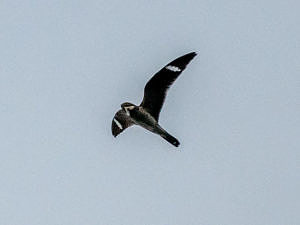
The proud (and protective) papa in flight on the evening of June 16, 2021. (photo © Dave Hoitt)
If the chicks survive, the parents will continue to feed them nightly, resulting in a fairly predictable pattern of behavior that can be observed from the sidewalk below. If the chicks do not survive, a change in the adult birds’ behavior will also clue us in to the failure. Nighthawk chicks typically take their first flight at 18 days old, and are able to make short flights at 21-23 days. The father nighthawk will continue to feed the chicks even after they fledge, so if the young survive, we may be able to watch these birds for another month or more.
You can help.
KSC
We are still interested in your nighthawk sightings — especially booming and diving — from other parts of town, but it’s vital to continue monitoring at KSC. This nest is not easily accessible, and the best thing for the nighthawk family is to disturb them as little as possible, so watching from the ground below will be crucial for detecting nest success. Watch at Elliot Hall from 8 to 9:30 p.m. on any calm, clear night over the next few weeks. The best vantage points are from the sidewalk between Rhodes and the library, and from the courtyard between the library, Elliot Hall, and the Sculpture Studio. If possible, team up with another volunteer or two, so you can watch from different angles, and keep a sharp eye on the north side of Elliot Hall, facing the library. Nesting females can be quite stealthy.

A female Common Nighthawk, photographed in California. Males have a conspicuous white tailbar and throat patch, both of which are absent here. (photo © Tom Benson)
Elsewhere
Although it’s most important to monitor the KSC nighthawk family at this time, if you want to conduct individual watches at other sites with gravel roofs to determine if we have more than one breeding-season pair in Keene this year, we welcome that too.
Here are a few sites that have not yet been watched: the People’s United Bank on Gilbo Avenue, the Hannafords plaza, “Washington Park” (the old Keene Middle School), the northeast corner of Central Square (in the vicinity of Luca’s and Bank of America, both of which have gravel roofs), Franklin School on Washington Street, and Production Avenue.
If you’re curious as to whether a building has a gravel roof, Google Maps satellite view is a great tool. Gravel roofs appear tan on aerial photos; vinyl roofs appear black or white. The only caveat is that Google does not reflect recent roofing work. For instance, KSC’s Media Arts Center roof was converted from gravel to vinyl three years ago, but still appears as gravel on Google.
A Few Important Reminders
(1) Be precise in your description of the behavior you observe, particularly with regard to timing.
(2) Record it all on a data sheet (which you can download here).
(3) Email your observations to Brett Amy Thelen as soon as possible after your watch.
(4) Reports of “null data” − when you’ve looked for nighthawks, but didn’t find any − are just as important as reports of activity, especially at the nest site. Peent!
A Hopeful Start to the Season

Common Nighthawk in flight.
(photo © Gordon F. Brown)
A trio of nighthawk watchers conducted the first watch of the 2021 season on June 7 at Keene State College, where they observed a male diving, booming, and peenting over Elliot and Rhodes Halls from 8:21 to 8:49 p.m., from 8:54 to 9:02 p.m., and again from 9:17 to 9:23 p.m. They also got several glimpses of a second, silent bird (presumably a female), which the male accompanied in a high flight over campus at 8:32 p.m. A nighthawk also flew from the Elliot roof to the Sculpture Studio roof at 8:51 p.m., and departed the Sculpture Studio roof, quacking, at 8:53 p.m. Quacking is a defensive sign, and the rooftop comings and goings combined with near-continuous displaying by the male are promising signs that this pair may once again be investigating a rooftop nest site at KSC!
Now what?
We haven’t watched anywhere else just yet, so we’re interested in your nighthawk sightings − especially booming and diving − from other parts of town. It’s also important to continue monitoring at KSC. If there’s a nest there, the birds should exhibit a fairly predictable pattern of behavior.
You can help.
KSC. We need people to watch for nighthawks at Elliot and Rhodes Halls from 8 to 9:30 p.m. or so on calm, clear nights over the next few weeks. The best vantage points are from the courtyard behind the library and the sidewalk between the library and Rhodes Hall.
Elsewhere. We’d also love for folks to conduct individual watches at other sites with gravel roofs and/or a history of nighthawk activity, to determine if we have more than one breeding-season pair in Keene this year. Good places to start: the People’s United Bank on Gilbo Avenue; 33 West Street (near Central Square); and Aubuchon Hardware in the Hannaford’s shopping plaza on West Street.
Remember…
(1) Be precise in your description of the behavior you observe, particularly with regard to timing.
(2) Record it all on a data sheet (which you can download here).
(3) Email your observations to Brett Amy Thelen as soon as possible after your watch.
(4) Reports of “null data” − when you’ve looked for nighthawks, but didn’t find any − are just as important as reports of activity, especially at the potential nest site. Peent!
Contact Us
For more information or to volunteer, please contact Brett Amy Thelen at (603) 525-3394 or by email.
